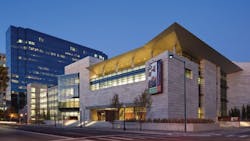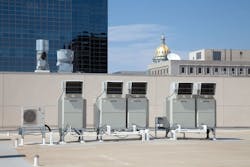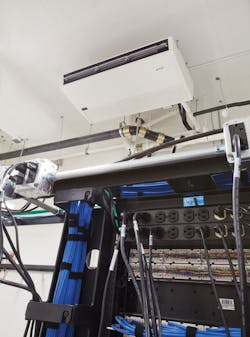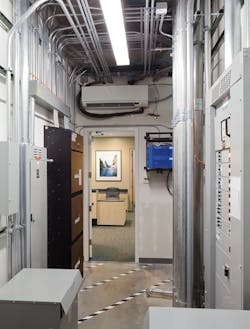Variable-Refrigerant-Flow Zoning System Helps Protect Museum’s ‘Nerve Centers’
In 2008, History Colorado, formerly the Colorado Historical Society, began planning a new headquarters and history museum in Denver’s Golden Triangle Museum District. Designer MKK Consulting Engineers Inc. of Greenwood Village, Colo., was seeking a reliable, high-performance HVAC system to protect the museum’s eight “nerve centers”: four electrical rooms containing large transformers, switchgear, network equipment, and lighting and breaker panels and four data closets loaded with database servers, IP-phone connectivity, fiber-optic equipment, an analog phone network, security equipment, and point-of-sale equipment. As required by the Governor’s Office of Information Technology, the rooms needed to be maintained at 76°F. What’s more, with historical data, communications, and security, as well as the function of sophisticated museum exhibits, at stake, the cooling system could not fail.
MKK specified the cooling system for these eight vital stations be separate from the large variable-air-volume (VAV) mechanical systems that would cool and heat the museum’s offices, conference rooms, and exhibit, presentation, and common areas.
“It is critical to have the controls for these nerve-center systems be entirely separate from the control systems of the rest of the building,” Chief Building Engineer Doug Crowell said. “If the main VAV system fails, the IT (information technology), electrical, and AV (audiovisual) rooms will not be impacted. In fact, to be really secure, we maintain a constant temperature of 67°F in all these eight centers.”
Mission-Critical Cooling
Reliable temperature control is needed when Rocky Mountain temperatures dip below 0°F, as they often do. Charles Landherr, commercial area sales manager for Mitsubishi Electric Cooling & Heating, urged MKK to consider specifying a variable-refrigerant-flow (VRF) zoning system equipped with a Low Ambient Cooling Kit, which guarantees cooling operation down to −10°F.
VRF zoning systems are well-suited to applications requiring precise temperature control. Mitsubishi Electric compressors use inverter-driven technology that responds instantly to minute indoor- and outdoor-temperature changes. These systems vary compressor speed to meet load requirements and maintain setpoint temperature.
Project Manager Chris Zalinger of Denver-based RK Mechanical Inc. said a challenge in cooling server rooms and electrical closets is that, often, they are spread throughout a building, as was the case with the History Colorado Center.
“Because of Mitsubishi Electric VRF systems’ flexibility and extremely long line lengths, designers can now combine these rooms on one system,” Zalinger said. “This approach helps save on installation costs by reducing the amount of equipment, electrical wiring, and piping on a project.”
MKK agreed: “It made better sense to specify Mitsubishi Electric’s VRF zoning system because it can serve up to 50 indoor units with one outdoor unit, greatly reducing the number of condensing units on the roof. This leads to a reduction of electrical connections and roof penetrations.”
Year-Round Cooling
Operating an air-cooled air-conditioning system in cold weather—when the condensing unit is installed outdoors—presents a unique set of problems that must be overcome for the system toThe Low Ambient Cooling Kit includes rear and side wind deflectors and a hood with damper controls. An outside-air sensor controls damper position. When the outside-air temperature drops below 23°F, the dampers close in pre-programmed increments, lowering airflow through the outdoor unit. The lower the temperature, the more the dampers close.
“I knew the Low Ambient Cooling Kit was vital to the success of the data-protection installation,” Craig Watts, PE, LEED AP, principal of MKK Consulting Engineers, said. “It also became clear that a competitor’s system did not have the technology to meet this need. Having the kit made my choice simple.”
Best System for the Job
Zalinger added: “Mitsubishi Electric’s unique two-pipe heat-recovery and heat-pump systems provide unmatched flexibility to meet any building needs. With the introduction of the Low Ambient Cooling Kit, Mitsubishi Electric extended the cooling operation down to −10°F. This is unquestionably a beneficial technology for use with small data centers and electrical closets that generate a constant heat load.”
Crowell added: “In my past work, our IT (and) server rooms were water-cooled using cooling towers, which are costly, very high maintenance, and take up a lot of real estate on the roof. Even though we have had record heat this summer (2012) in Denver, we have not had a single issue related to the units themselves. I am pleased and impressed with the excellent performance of our Mitsubishi Electric VRF zoning systems.”
For Design Solutions author guidelines, call Scott Arnold, executive editor, at 216-931-9980, or write to him at [email protected].



